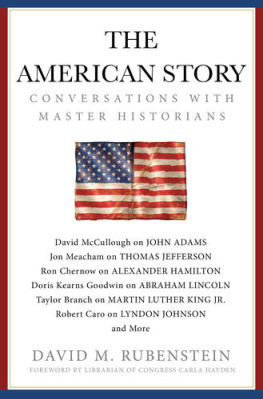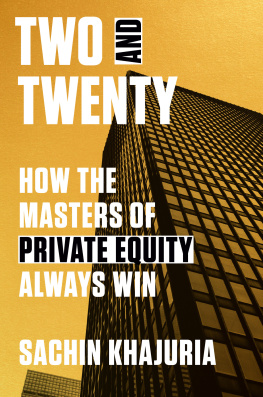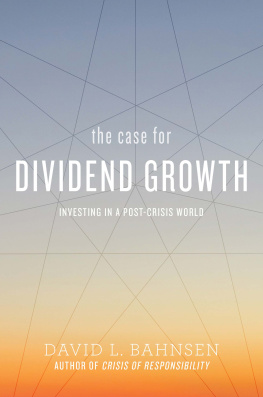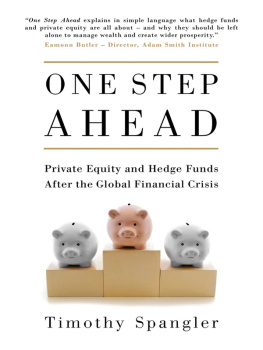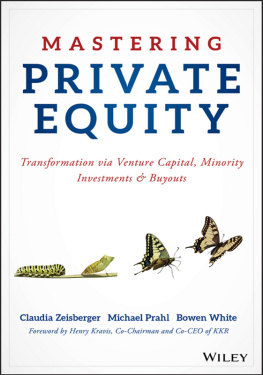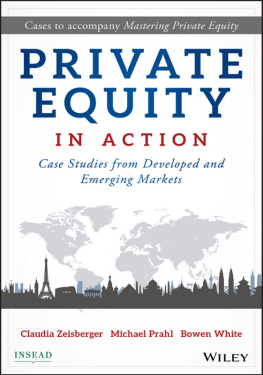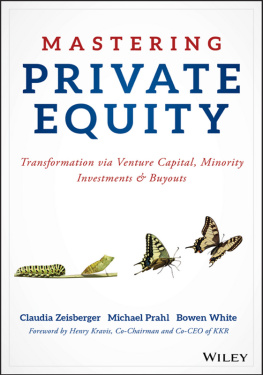How to Invest
Masters on the Craft
David M. Rubenstein
Cofounder of The Carlyle Group New York Times Bestselling Author
Thank you for downloading this Simon & Schuster ebook.
Get a FREE ebook when you join our mailing list. Plus, get updates on new releases, deals, recommended reads, and more from Simon & Schuster. Click below to sign up and see terms and conditions.
CLICK HERE TO SIGN UP
Already a subscriber? Provide your email again so we can register this ebook and send you more of what you like to read. You will continue to receive exclusive offers in your inbox.
To Warren Buffett, the ultimate master of the investor craft, and to Bill Conway and Dan DAniello, who patiently showed me firsthand, for thirty-five years, the craft of investing and the art of partnership.
Introduction

M uch of life simply revolves around predicting the future and then taking actions that reflect the view of that future. Like everyone, I have made some good and bad predictions about the future, and taken some smart and not-so-smart actions based on those predictions.
I thought Jimmy Carter would beat Gerald Ford in the 1976 presidential election and, also believing he was the better candidate, went to work for Carters general election campaign. Good prediction.
I thought Ronald Reagan was too old (69), too conservative, and too lacking in policy skills to beat Carter in the 1980 presidential election, and I did not plan for a postJanuary 20, 1981, forced return to private-sector life. Bad prediction. (I am now older than Reagan was thenhe now seems like a teenager.)
I thought my Little League all-star skills at shortstop would not likely grow into a major-league career and decided to focus my efforts on improving my academic skills rather than my athletic skills. Good prediction.
I thought my hometown Baltimore Colts could not possibly lose to Joe Namath and the upstart New York Jets in Super Bowl III in 1969, and made a very large (for me) bet on the Colts. Bad prediction (and my last-ever sports bet).
I thought the private equity world would increase in appeal and that it was possiblewith the help of talented investment professionals I was able to recruitto build a global private equity firm from a Washington base. Good prediction (maybe my best ever).
I thought Mark Zuckerbergs company, created while he was in college, would not outgrow its college campus roots and thus would not be an attractive investment for me when presented by my future son-in-law. Bad prediction.
I thought Jeff Bezoss startup books-over-the-internet company could not possibly overcome Barnes & Noble, and told him that in our initial meeting at his cluttered first office space in Seattle, and thus later decided to sell our Amazon stock as soon as possible. Bad prediction.
Whether someone has predicted well or poorly about life events can be gauged differently by different people. In truth there is no single, universally accepted standard to gauge how successful someone has been in predicting and acting on the future.
In that respect at least, the investment world is wholly different. The skill of predicting the future, and taking preparatory actions, is quite measurable. In the investment world, achieving a profitto a lesser or greater degree depending on the type of investmentis the essence of investing.
In working to achieve a profit, an investor is really making a prediction about the futurethe desirability of owning a particular asset (stock, bond, house, currency, etc.) in the future, based on the likely future performance of the asset. Will the company attract new customers or invent a desired product? Will the economy at the time the investment is realized be strong or weak? Will interest rates be higher? Will climate change affect the value of assets? Will competition be less than might be expected?
Stated differently, are there risks that will possibly arise that could upset the investors belief that an investment will work out and thus produce the desired outcome? And how great are those risks?
In life, there are always risks to be assessed, but the consequences may not always be measured precisely. In investing, the consequences can be measured quite precisely.
While investing today is a much more sophisticated process of trying to predict the future than it was in the past, the process of investing is centuries old, though by todays standards it was not all that sophisticated back then. Ever since money or its equivalent has existed, individuals have tried to take steps that will return to them more of something than they invested. In the United States, the country was basically started as an investment. The settlers in Jamestown, Virginia, arrived in 1607 because their financial backers in England expected the settlement would ultimately return multiples of the sums that were invested to get the settlers there. That turned out not to be a great investment for the initial backers.
In the past half century, the gold standard as an investor, and thus as a predictor of the future, has been Warren Buffett. He first bought shares of Berkshire Hathaway at $7.50 per share, and over the past sixty years the share price has compounded at an annualized rate of 20 percent. Others have made more money outside of the investing world. Others have had better investment rates of return over shorter periods of time. And still others have had more visible and spectacular investment returns on particular investments. But no other investor has achieved more over a longer period. Berkshire Hathaway now has a market value of $690 billion as of June 1, 2022. Thus Warren Buffett might be said to be the best long-term predictor of the future. For that is what he has in essence been doing all of these years.
I have interviewed Warren many times, as have others, and have always learned something new from him when interviewing him or reading the interviews of others. Those interviews made me think about the views of other great investorshow were they able to predict the future, in their own area of investment, and how were they able to act well or not so well on those predictions?
That led me to an effort to interview some of Americas best investors to gauge how they prepared themselves to both predict the future and act upon it in their own area of specialty. The result is this book, which is a distillation of those interviews, with some of my own thoughts about each of the investors and their investment types, as well as some of my perspectives on investing. As with my previous books, the interviews have been edited for length and clarity with the permission of the interviewees.
Great investors have a number of skills and attributes in common, as I will discuss. But they also have skills and attributes unique to their particular type of investment area. A great venture investor may not have everything required to be a great distressed-debt investor, or to be a great real estate investor, or a great cryptocurrency investor.
So I thought that, to give a reader a meaningful sense of the varying skills and attributes needed for different types of investment areas, it would be helpful to have leaders in many of the different basic investment areas. I interviewed individuals like Jon Gray, who built the worlds largest real estate investment business at Blackstone; Seth Klarman, who has long been, in his leadership at Baupost, one of the countrys most respected value investors; Michael Moritz, who helped build Sequoia into perhaps the most successful of the large venture funds over the past five decades; Mary Erdoes, who has led J.P. Morgans wealth management business into a world-leading position; John Paulson, whose bet against subprime mortgages between 2007-09 became known as the greatest trade in Wall Street history; John Rogers Jr., whose commitment to careful stock analysis led him to build one of the largest African Americanowned and led investment companies; and Jim Simons, whose math genius enabled him to pioneer the use of quantitative investment strategies.


